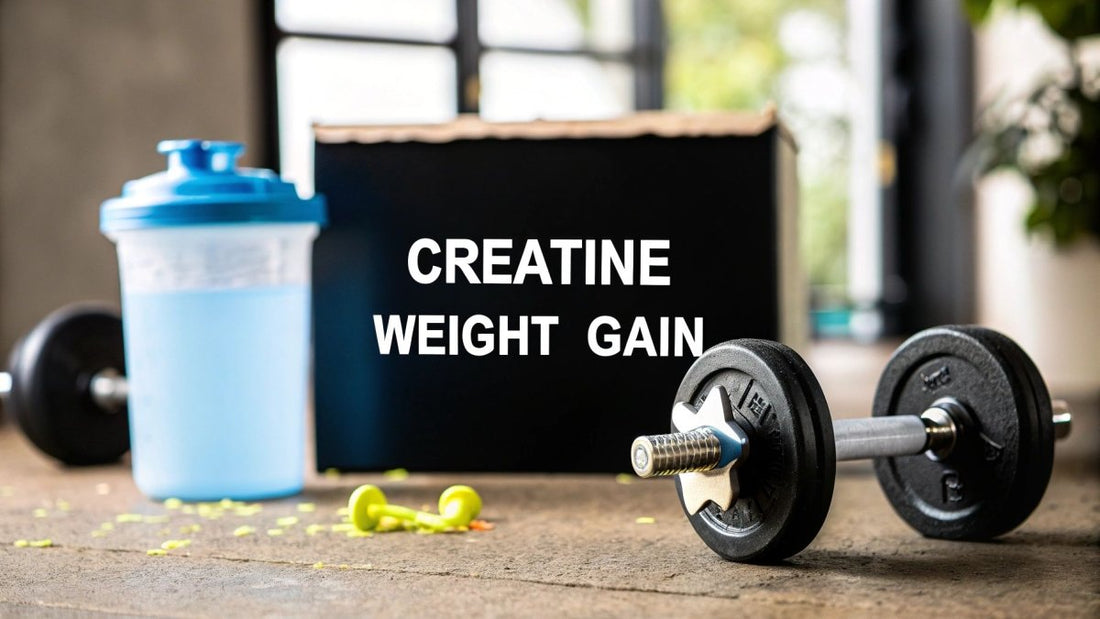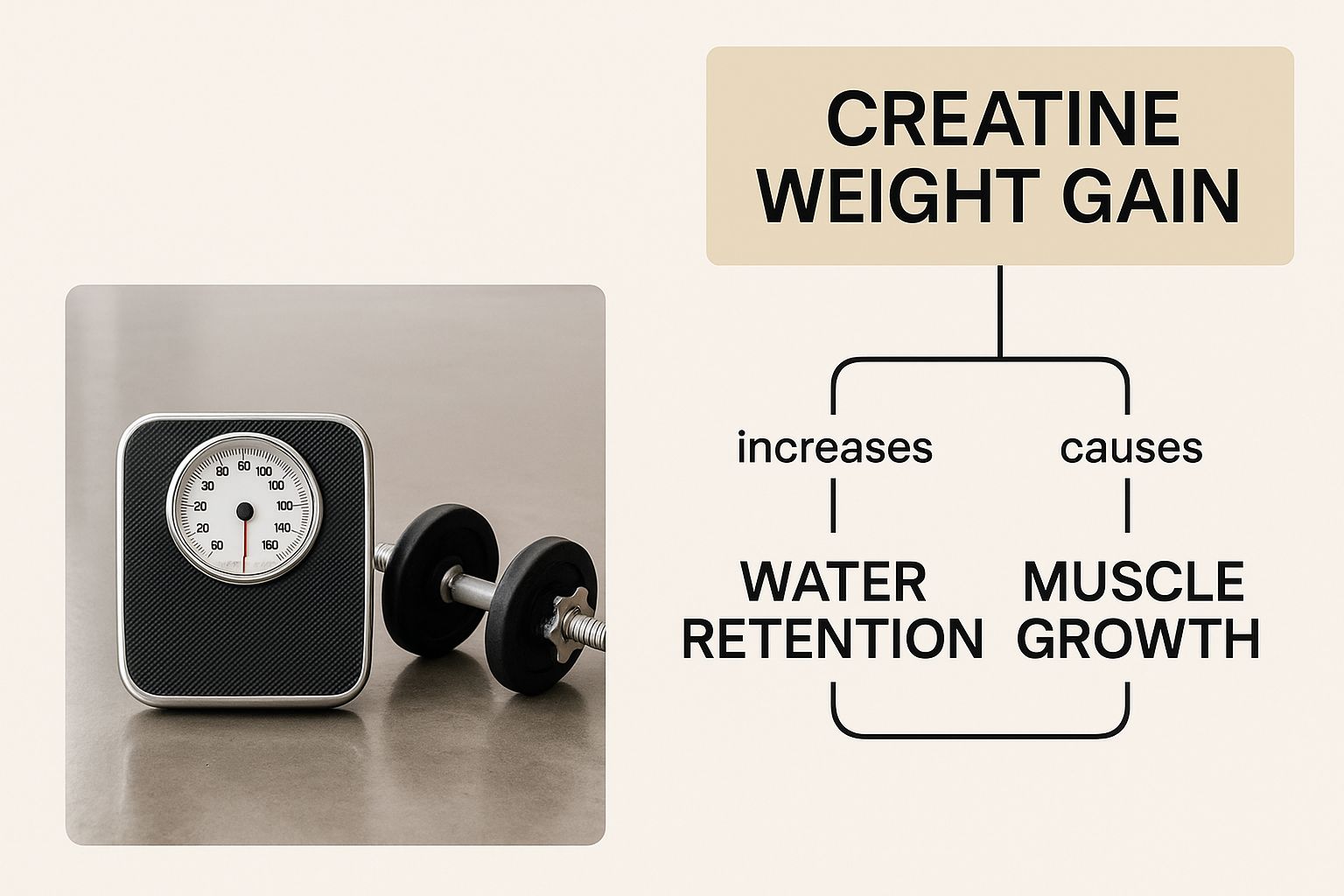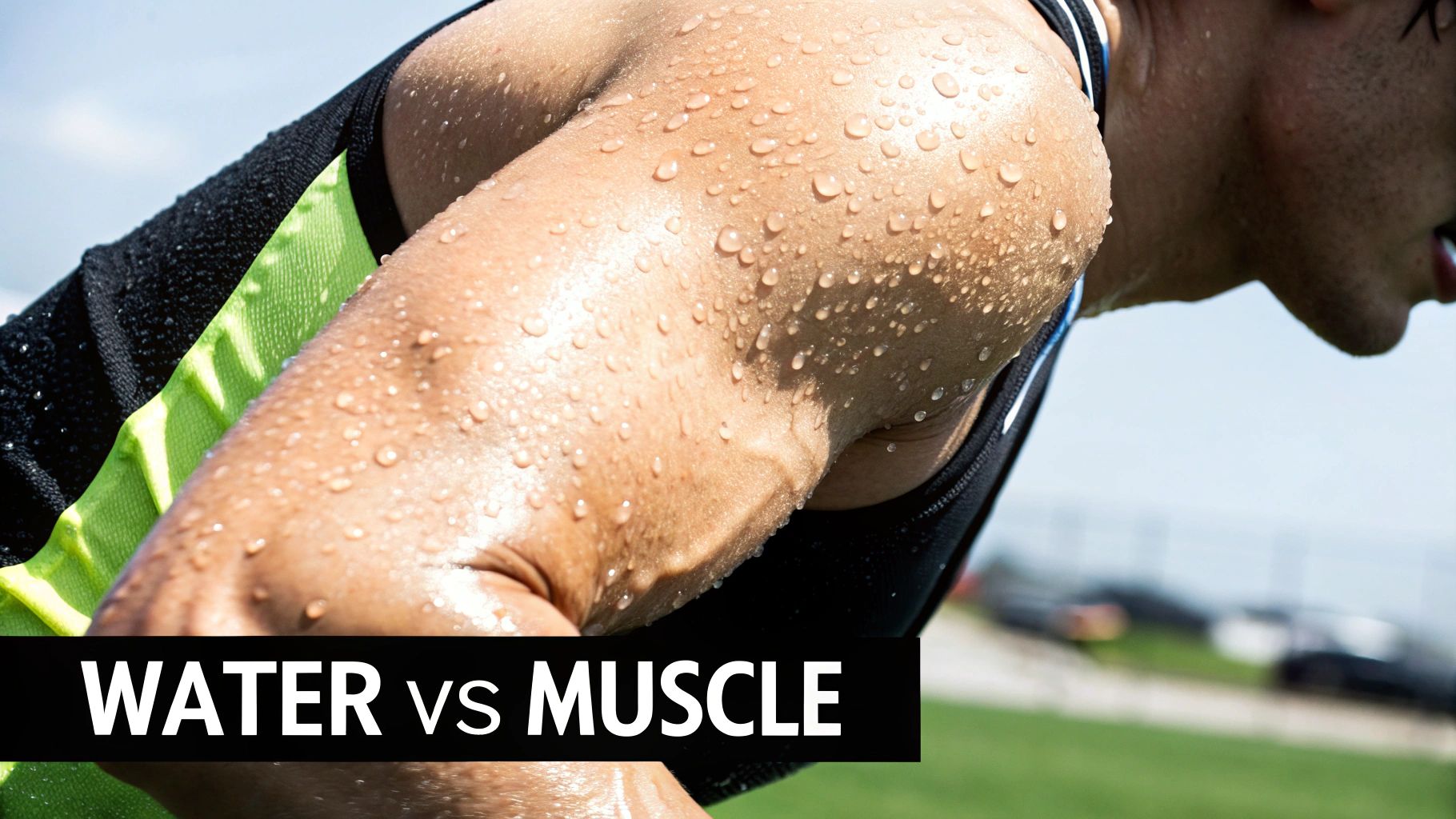
How Much Weight Gain Creatine Really Causes
Share
Let's cut right to the chase. If you've just started taking creatine, you can expect to gain between 2 and 9 pounds (roughly 1-4 kg) in the first month. But before you panic, understand this isn't fat. It's almost entirely water weight being pulled into your muscles, which is exactly what you want to see.
Your Guide to Creatine and Weight Gain
Hopping on the scale after a week of creatine can be a bit of a shock, but that initial jump is actually a great sign. It means the supplement is doing its job by saturating your muscles with creatine and, in the process, drawing water into the muscle cells.
This isn't the same as bloating. This process, called cellular hydration, gives your muscles a fuller, more "pumped" look and, more importantly, creates a better environment for actual muscle growth.
This guide will walk you through what that number on the scale really means. We'll cover:
- The crucial difference between initial water retention and long-term muscle gain.
- What you can realistically expect on the scale, week by week.
- Why your results might look completely different from your gym buddy's.
The infographic below gives a fantastic visual summary of what's happening inside your body when you start your creatine journey.

As you can see, that initial water gain is the first step. It directly fuels the performance boost you'll feel in the gym, which is what leads to real, lasting muscle development down the road.
How Much Weight Can You Expect to Gain?
Honestly, it varies a lot from person to person. One major study found that after 28 days, participants gained an average of 1.31 kg (about 2.9 lbs). But the range was huge—some gained as little as 0.47 kg, while others put on a whopping 3.92 kg.
Interestingly, some people in the study saw no weight change at all. This just goes to show how much your individual biology plays a role. It’s also why you shouldn't get too hung up on the scale. The real metric for success is how you're performing during your workouts.
To give you a clearer picture, here’s a quick breakdown of what to expect.
Creatine Weight Gain at a Glance
This table summarizes the key factors influencing weight gain when starting creatine, covering the type of gain, expected timeline, and what it means for you.
| Factor | What It Is | Typical Range or Timeline |
|---|---|---|
| Initial Water Weight | Water pulled into muscle cells (cellular hydration) during the loading phase. | 2-5 lbs within the first 5-7 days. |
| Sustained Weight Gain | A mix of continued water retention and the beginning of real muscle growth. | 2-9 lbs total by the end of the first month. |
| Long-Term Muscle Mass | Actual muscle tissue built over time, fueled by improved performance. | Varies greatly; depends on training, diet, and genetics. |
Ultimately, this table shows that the initial weight is just a temporary phase leading to the results you're really after.
The initial weight gain is just the beginning. The real magic happens when you use that newfound energy and hydration to push for an extra rep or add more weight to the bar. That’s what ultimately builds solid muscle. To dive deeper into this, you can learn more about how creatine helps make you bigger in our detailed article.
Water Weight vs. Muscle: What’s Happening in Your Body?

So you've started taking creatine, and suddenly the number on the scale has jumped up. It's completely normal to wonder what's going on. Is it fat? Is it muscle? The answer is a bit more nuanced, and it all comes down to what's happening inside your muscle cells.
This isn't the same kind of water retention you get from a salty meal. Creatine is like a magnet for water, but it's very specific about where it works. When you supplement, creatine travels directly to your muscle tissue and pulls water into the cells. This process is called intracellular hydration.
The key takeaway here is that the water is being held inside your muscles, not just under your skin. This is exactly why your muscles might look and feel fuller and more "pumped," especially during the first week or two. But this isn't just for show—this cellular swelling actually creates an anabolic environment that signals your muscles it's time to get stronger.
The Two Phases of Creatine Weight Gain
The weight you gain from creatine almost always happens in two distinct stages. Knowing the difference between them is crucial for setting realistic expectations and tracking your progress.
Phase 1: The Initial Water Rush (Days 1-7) This is where you'll see that quick, almost overnight jump on the scale. As your muscles soak up creatine, they also draw in a significant amount of water. This is a clear sign that the supplement is doing its job and your muscles are getting saturated.
Phase 2: Building Real Muscle (Week 2 and Onward) Once your muscles are fully hydrated and primed for action, the real magic begins. This is where your hard work in the gym starts paying off in a big way.
Creatine acts as a reserve fuel tank for your muscles during intense bursts of effort. It helps regenerate adenosine triphosphate (ATP), your body's primary energy currency. This means you can squeeze out more reps, lift heavier, and push your workouts harder, which is the true catalyst for long-term muscle growth.
So, how much of that initial gain is water versus muscle? In the beginning, it’s almost 100% water. But that initial water weight is what lays the foundation. It supports the enhanced performance that allows you to build real, lasting muscle mass over the following weeks and months.
Don't Forget to Hydrate
Since creatine is actively pulling water into your muscles, staying on top of your hydration is non-negotiable. You have to give your body enough fluid to manage this process while also supporting all your other biological functions.
Skimping on water can lead to dehydration, which will sabotage both your performance in the gym and your overall results. To make sure you're properly fueled, drink plenty of water throughout the day. For a more detailed breakdown, you can learn about the ideal water intake with creatine in our comprehensive guide.
Ultimately, that number on the scale reflects a powerful two-step process: beneficial water retention that fuels better workouts, which then leads to the lean muscle gains you're after.
Your First Month on Creatine: What to Expect
Starting your creatine journey is an exciting time, but it’s a process, not a switch you flip for instant results. The first month is where you'll see some of the most noticeable changes—both on the scale and in the gym—so it helps to know what’s coming.

The biggest shift usually happens right out of the gate. In that first week, especially if you opt for a "loading phase" with higher doses, you'll likely see a quick jump on the scale. Don't sweat a sudden gain of 2 to 5 pounds. This is just the initial water retention as your muscles get fully saturated with creatine. It’s a good sign!
The First Week: The Water Phase
Think of this initial period as your body’s hydration kickstart, but at the cellular level. Your muscles are acting like sponges, pulling in both creatine and the water that comes with it. This is a clear indicator that the supplement is doing its job. The number on the scale is just reflecting this normal physiological process.
This isn't just anecdotal, either. A huge review of 143 studies found that people taking creatine gained, on average, 0.86 kg (about 1.9 pounds) more than the placebo groups. The effect was even more pronounced when they combined it with resistance training. You can dig into the full analysis of these creatine findings on Taylor & Francis Online. This early water gain is just setting the stage for the real work.
Weeks Two to Four: Performance Gains
After that first week, the rapid weight gain usually levels off. Your muscles have reached their saturation point, and now the focus shifts from simple hydration to actual performance. This is where the magic really starts to happen in your workouts.
You might find yourself pushing out one more rep on your last set of bench presses or feeling strong enough to add another plate to your squat. This is the period when creatine really starts fueling tangible improvements in your strength and endurance.
From this point on, the scale becomes a much less important metric. Real progress is measured by the weight you’re lifting, the reps you’re hitting, and how you feel in the gym.
It’s crucial to look beyond the day-to-day blips on the scale. Start tracking your performance metrics instead—those are the true indicators of progress. Making that mental shift from obsessing over body weight to focusing on strength is key to using creatine to crush your goals. To learn more about this timeline, check out our guide on how long it takes to see results from creatine.
What Affects How Much Weight You Gain on Creatine?
Ever watched a friend pack on five pounds in their first week of taking creatine while you only saw the scale budge by two? It can be puzzling, but the truth is, there's no single answer to how much weight gain creatine causes. Your results are your own, shaped by a unique blend of personal factors.
Let's break down what those variables are. Understanding them will help you set realistic expectations for what you'll see on the scale and in the mirror.
Your Starting Point Matters
Think of your muscles like sponges. The bigger the sponge, the more water it can soak up. It's the same with creatine. Someone who already has a good amount of muscle mass simply has more tissue to store creatine and the water that gets pulled in with it.
This means if you're a seasoned lifter with significant lean mass, you've got more "storage tanks" in your muscles. You're likely to see a more noticeable jump on the scale right away. A beginner, on the other hand, has less muscle to start with and will probably see a smaller, more gradual increase.
How You Train and Eat
Here's a hard truth: creatine doesn't build muscle by itself. It's the fuel for the hard work that does. You get the most out of creatine when you pair it with intense, consistent resistance training. The harder you push, the more you tap into its energy-boosting benefits, which is what actually stimulates muscle growth over time.
Your diet is the other side of the coin. Some research shows that taking creatine with carbohydrates can give it a helping hand. Carbs spike insulin, and insulin acts like a key, unlocking your muscle cells to shuttle creatine in more effectively. A simple way to do this is to have your creatine with a meal or in a post-workout shake that has some carbs.
Your creatine journey is yours alone. It's a mix of your body, your diet, and the grit you show in the gym. Don't get caught up comparing your results to someone else's—focus on your own progress and performance.
Your Unique Genetic Blueprint
Finally, we can't ignore genetics. A small fraction of people are what we call "non-responders" to creatine. This just means their bodies, for whatever reason, don't store extra creatine as well as others. For them, the changes in weight and performance might be minimal.
This has nothing to do with effort—it's just biology. So, if you've been consistent and don't see a big change, it could just be how you're wired. By understanding these key factors, from your fitness level to your genetics, you can make sense of the number on the scale and focus on what really counts: getting stronger.
So, Does Creatine Actually Make You Fat?
Let's clear the air on one of the biggest myths out there: creatine does not cause fat gain. It's a stubborn misconception, but the science and real-world experience just don't back it up.
The weight you see creep up on the scale, especially in the first week or two, is almost entirely from water being drawn into your muscle cells. Later on, that number reflects the new, hard-earned muscle you've built by pushing yourself harder in the gym.
A Catalyst for a Leaner Physique
In a way, creatine does the exact opposite of making you fat. It's a powerful tool for improving your body composition, helping you sculpt a leaner and stronger frame. This isn't just wishful thinking; it's a direct result of how creatine works.
First, by giving your muscles more readily available energy, creatine lets you train with more intensity. You can squeeze out that extra rep or add another plate to the bar, which translates directly to more calories burned during your workouts.
Second, the muscle you build is metabolically active. This means it torches more calories throughout the day—even when you're just sitting on the couch—compared to fat tissue.
Think of your muscles as the engine of your body. Creatine helps you upgrade that engine. A bigger, more powerful engine not only performs better but also burns more fuel (calories) just by being there.
This creates a powerful cycle: better performance leads to more muscle, and more muscle leads to a higher resting metabolism. Over time, this can significantly lower your body fat percentage, even if your total body weight increases.
Shifting Your Body's Makeup
The goal here is to gain functional, athletic weight—not unwanted body fat. That’s why it's so important to shift your focus from the number on the scale to how you're performing in the gym and how your clothes are starting to fit differently.
Research consistently shows that creatine is a powerful ally for anyone looking to improve their body composition. For instance, a major review of studies on adults over 50 found something pretty compelling: those who combined creatine with resistance training saw a significantly greater drop in body fat percentage than those who just lifted weights.
This really drives home the point that creatine helps tip the scales in favor of a leaner, more muscular physique. You can dive into the details of that study yourself and explore the benefits of creatine for body composition via the National Center for Biotechnology Information.
Smart Ways to Approach Your Creatine Use
Getting the most out of creatine is less about just taking the powder and more about having a smart plan. A little bit of strategy goes a long way in making sure you get the performance boost you’re after while knowing exactly what’s happening on the scale.
The first decision you'll make is how you want to start. There are two tried-and-true methods, and the best one for you really just depends on your goals and how patient you are.
Choosing Your Dosing Protocol
You can jumpstart the whole process with what's known as a "loading phase." This just means taking a higher dose for the first week to quickly fill up your muscle's creatine stores. This is the fastest way to see results, both in the gym and with that initial water weight gain.
- The Loading Phase: You'll take 20 grams per day for about 5-7 days. To make it easier on your stomach, split this into four separate 5-gram doses.
- The Maintenance Dose: After that first week, you’ll drop down to a steady 3-5 grams per day. This is all you need to keep your muscles saturated.
The other option? Just skip the loading phase altogether.
You can simply start with the maintenance dose of 3-5 grams a day right from the get-go. Your muscles will eventually reach the same saturation point—it just takes a bit longer, usually around three to four weeks. The weight gain will be much more gradual, which many people find less jarring.
Both roads lead to the same destination. Loading gets you there in a week; sticking to a maintenance dose gets you there in about a month. One isn't better than the other, it's just a matter of preference.
Hydration is Non-Negotiable
Remember, creatine works by pulling water into your muscle cells. For it to do its job properly, you have to give it the water it needs. If you don't stay hydrated, you're essentially short-circuiting the whole process.
Not drinking enough water won't just hold back your results; it can also lead to things like muscle cramps or an upset stomach. Make a conscious effort to drink plenty of water all day long. It's fundamental to letting creatine work its magic.
Look Beyond the Scale
This is probably the most important tip of all: stop focusing so much on your total body weight. The scale is a terrible progress tracker when you're using creatine because it can't tell the difference between water, fat, and new muscle.
Instead of getting hung up on daily weight changes, start tracking the metrics that actually show you're getting stronger.
- Strength Gains: Are you adding more weight to the bar?
- Increased Reps: Can you squeeze out an extra rep or two on your big lifts?
- Better Endurance: Are you getting through your workouts with less fatigue?
- Faster Recovery: Do you feel less sore and more ready for your next training session?
These are the real signs that creatine is working for you. When you focus on performance, you get a much more accurate—and motivating—picture of your progress.
A Few Lingering Questions About Creatine
Even with all the science laid out, you probably still have a couple of specific questions bouncing around in your head. It's totally normal. Let's tackle some of the most common ones I hear so you can move forward with confidence.
How Long Does the Creatine Water Weight Last?
This is a big one. The initial water weight you gain isn't like the temporary bloating you get from a salty meal; it's functional. As long as you keep taking creatine and your muscles stay saturated, they're going to hang onto that extra water.
And that's a good thing! This process, called cell volumization, is what helps support better performance and gives your muscles that fuller, denser look. If you ever decide to stop taking creatine, your body will gradually let go of this extra water over a few weeks as your creatine stores return to normal.
Will I Lose Muscle if I Stop Taking Creatine?
Let’s be clear: you won’t lose the actual, hard-earned muscle you’ve built in the gym. The strength and size you've gained from lifting weights and eating right are yours to keep, as long as you stick with your training and nutrition.
What you will notice is that your muscles might look a bit smaller or "flatter." That's just the extra water leaving the muscle cells. You might also feel a slight drop in your top-end strength or find you can't quite squeeze out that last rep, since you're missing that extra bit of readily available energy.
The real muscle you built is still there. Think of it like taking a supercharger off a car engine. The engine itself is just as strong, but it's lost that immediate, on-demand power boost.
Should Women Avoid Creatine Because of Weight Gain?
Absolutely not. This is probably one of the most persistent myths out there, and it stops a lot of women from getting amazing results. The weight women gain from creatine is the exact same as it is for men: functional water and lean muscle mass. This combination leads to a more toned, athletic physique, not unwanted "bulk."
In fact, because women typically have a different hormonal profile and starting muscle mass than men, the total number on the scale often doesn't jump as dramatically. The benefits, however—more strength for your lifts, better endurance, and faster recovery—are just as powerful. It’s all about focusing on your performance and how you feel, not just a number on the scale.
Ready to build strength without the messy powders? Smash.com offers delicious, convenient creatine gummies that deliver the full 5g dose in every serving. Find your favorite flavor and fuel your fitness journey with Smash.com.